Fall is a great time to plant trees in the landscape. The soil is warm and air temperatures are generally cooler, creating a better environment for the tree and the gardener doing the planting. The cooler temperatures promote root growth which helps the tree establish a more robust root system before new growth begins the following spring.
Proper planting as well as timing is important for growing healthy long-lived trees that provide shade, reduce energy costs, help manage storm water and so much more. Reduce the risk of injury, inconvenience, and expense by calling 811 at least three business days before putting the first shovel in the ground. This free service contacts all the utility companies who will mark the location of the underground utilities in your work area. Look up and avoid planting trees under overhead utilities.
Select trees suited to the growing conditions and those that will fit the available space once they reach full size. Trying to keep a 40-foot-tall tree at 15 feet negatively impacts the tree’s natural beauty and requires lots of work on your part.

Once you select the right tree for the location make sure to give it a safe ride home. Transporting the tree in a pickup truck or trailer is easier for you and better for the tree. If this is not an option, consider spending a bit more money to have the nursery safely deliver your tree.
When transporting your tree, use a tarp to cover the top of the tree to prevent wind damage to its leaves. Protect the trunk by wrapping it with a towel where it will rest on the vehicle. Always move the tree by the root ball, not the trunk, to prevent damage to the roots.
Keep your tree in a cool, shaded location until planting. Mulch balled-and-burlapped trees with wood chips to help keep their roots moist. Water these and container-grown trees daily or as often as needed to keep the roots slightly moist.
Locate the tree’s root flare, also called the trunk flare. This is where the main roots angle away from the trunk. Dig the planting hole to the same depth as the distance between the root flare and the bottom of the root ball so the root flare is at or slightly above the soil surface. Digging deeper can result in the soil settling and water collecting in the depression around your tree. Make the hole at least three to five times wider than the root ball.
Roughen the sides of the planting hole to avoid glazed soil that can prevent the roots from growing into the surrounding soil. Carefully remove container-grown trees from the pot and loosen or slice pot bound and girdling roots circling the trunk and root ball before planting.
Place the tree in the planting hole so the trunk is straight and the tree is facing the desired direction. Remove the tags and twine and cut away any wire baskets and burlap on balled-and-burlapped trees.
Fill the planting hole with existing soil so the roots adjust to their new environment. Avoid amending the soil as this encourages the roots to stay in the planting hole instead of moving out into the surrounding soil.
Water thoroughly to settle the soil and moisten the root ball and surrounding soil. Spread a two- to three-inch layer of wood chips or shredded bark over the soil surface surrounding the tree. Pull the mulch back several inches from the trunk. Mulching helps conserve moisture, moderate soil temperature, reduce competition from grass, and prevent weeds. It also keeps tree-damaging mowers and weed whips away from the tree trunk while eliminating the need for you to hand trim.
Only remove broken, damaged, and rubbing branches at the time of planting. Research shows that the more leaves a tree has, the more energy it can produce, and the quicker it develops new roots and recovers from transplant shock. Begin structural pruning in a few years once the tree has adjusted to its new home.
Continue watering as needed. It takes several years for trees to develop a robust root system that is better able to access water from a larger area. Water thoroughly when the top four to six inches of soil is crumbly and moist. Apply enough water to wet the top twelve inches of soil.
The time you invest in proper planting and care will pay off in years of enjoying the shade, beauty, and other benefits your tree provides.
 Melinda Myers has written more than 20 gardening books, including the recently released Midwest Gardener’s Handbook, 2nd Edition and Small Space Gardening. She hosts The Great Courses “How to Grow Anything” instant video and DVD series and the nationally syndicated Melinda’s Garden Moment TV & radio program. Myers is a columnist and contributing editor for Birds & Blooms magazine and her website is www.MelindaMyers.com.
Melinda Myers has written more than 20 gardening books, including the recently released Midwest Gardener’s Handbook, 2nd Edition and Small Space Gardening. She hosts The Great Courses “How to Grow Anything” instant video and DVD series and the nationally syndicated Melinda’s Garden Moment TV & radio program. Myers is a columnist and contributing editor for Birds & Blooms magazine and her website is www.MelindaMyers.com.
